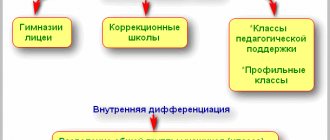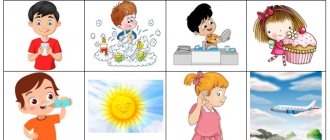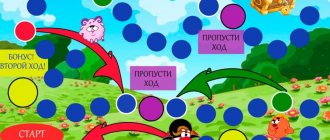Presentation: “Automation of the sound “R” in texts” - a multimedia guide to automating the sound “R” in coherent speech.
Automation of the sound “R” in tests occurs after the production of the sound, automation in syllables, in words, phrases, sentences.
Material on automating the sound “R” can be found at the link.
Automation of the sound “R” in texts can occur simultaneously with automation in poems and tongue twisters.
Before you start automating the “P” sound in tests, do articulation gymnastics. Articulation gymnastics - special exercises. These exercises will prepare the speech apparatus to pronounce this sound.
Since the automation process usually takes a long time, a huge amount of material is required.
On the site you can find both presentations for the development of coherent speech and picture material. Visual material can be printed, laminated for longer-term use and enjoyed.
You can also study online directly on the website. All illustrations are accessible, colorful and of good size. Follow the highlighted link and learn to pronounce the “R” sound correctly in texts.
Now let’s talk about presentations for automating the “R” sound in texts.
Benefits of presentations:
- All children love to play on computers and all kinds of gadgets. Therefore, this type of gaming activity will definitely interest them.
- All material and pictures are understandable for children.
- In the presentation, the child will be able to switch files himself, and this is an additional game moment.
- The presentation is a very accessible educational material that does not require any costs. All you need is a computer, laptop or tablet.
Also in this game guide are presented articulation exercises for the sounds “P”, “Рь”. They must be carried out before the start of the lesson in order to prepare the child’s speech apparatus to pronounce the sound “R” correctly.
You will find more complete information on performing articulatory gymnastics at the dedicated link.
In the presentation you will also find instructions for working on texts. You can read these instructions right now.
Presentation for a speech therapy lesson on the topic “Sound and the letter P” presentation for a lesson on the topic
Slide 1
Sound and letter R Author: Gilmutdinova Gulnaz Rinatovna, Teacher-speech therapist, MAOU Secondary School No. 5, Labytnangi Yamalo-Nenets Autonomous Okrug 2015
Slide 2
Guess the riddles: Beware of this cat - She is not a domestic cat, But a predatory one...
Slide 3
lynx
Slide 4
Articulation of sound
Slide 5
Say the sound [R] Is there an obstacle when we pronounce the sound [R]? Where does the air meet a barrier? So, which sound [P] is a vowel or a consonant? Does your throat tremble when pronouncing a sound? So, is the sound voiced or dull?
Slide 6
REMEMBER the sound [P]: CONSONANT VOICED HARD
Slide 7
Articulation gymnastics “Smile - Tube” Place the upper teeth on the lower ones, stretch your lips in a smile, showing all the teeth, hold the smile for 3 - 5 seconds, stretch your lips forward like a tube, hold your lips in this position for 3 - 5 seconds. Switch from one position to another 5 - 7 times. “Football” Stretch your lips forward with a tube and blow for a long time onto a cotton ball lying on the table in front of the child, driving it into the “goal”.
Slide 8
“Mushroom” Smile, show your teeth, open your mouth slightly, and pressing your wide tongue with its entire plane to the palate, open your mouth wide. Then the tongue will resemble a thin mushroom cap, and the stretched hyoid ligament will resemble its stem.
Slide 9
“Accordion” Smile, open your mouth slightly, stick your tongue to the roof of your mouth and, without letting go of your tongue, close and open your mouth (just as the bellows of an accordion stretch, so does the hyoid frenulum stretch). When repeating the exercise, you should try to open your mouth wider and wider and keep your tongue in the upper position longer. “Swing” Smile, show your teeth, open your mouth slightly, put your wide tongue behind your lower teeth (on the inside) and hold it in this position, counting from 1 to 5. Then lift your wide tongue behind your upper teeth (also on the inside) and hold it under count from 1 to 5. So, alternately change the position of the tongue 4 - 6 times.
Slide 10
“Brushing your teeth” Open your mouth and use the tip of your tongue to “brush” your upper teeth from the inside, moving your tongue from side to side.
Slide 11
“Horse” Smile, open your mouth, click the tip of your tongue (like a horse clicking its hooves). “Painter” Smile, open your mouth and stroke the hard palate with the tip of your tongue, moving your tongue back and forth.
Slide 12
“Drum” (“Woodpecker”) Smile, open your mouth (wide enough), put your tongue behind your upper teeth, tap your tongue on the roof of your mouth behind your upper teeth with the sound “D-D-D.” Tap the tongue for 7 - 15 seconds (for the entire exhalation).
Slide 13
Automation of sound in syllables Rara, ra-ra-ra Ro-ro, ro-ro-ro Ru-ru, ru-ru-ru Ry-ry, ry-ry-ry Ra-ro - ru-ry Ro-ru -ry-ra Ru-ry-ra-ro Ry-ra-ro-ru Dra-dra-dro-dru Droo-dro-dru-dra Droo-dru-dra-dru Droo-dra-dry-dro Tra - try - tro-tru T ry - tro-tru-tra T ro-tru-tra - try Tru-tra - tro-tro
Slide 14
Automation of sound in syllables The adult speaks The child of Paradise speaks goes to the market ar-ar-ar, ar-ar-ar. Fedor sweeps the yard, or-or-or, or-or-or. There are a lot of chickens at the trough, ur-ur-ur, ur-ur-ur. Iraida drinks kefir ir-ir-ir, ir-ir-ir. Smooth red tomato or-or-or, or-or-or. The farmer's name is Zakhar, ar-ar-ar, ar-ar-ar. The master cuts the cord, ur-ur-ur, ur-ur-ur.
Slide 15
Automation of sound in words Pronounce (read) the words RA-RA-RA - hole, bagels, pyramid, kids, mountain RA-RA-RA - cancer, frame, work, radio, wound, rocket RO-RO-RO - mouth, ditch , robot, Motherland, rose RO-RO-RO - frost, cottage cheese, crow RU-RU-RU - steering wheel, Rus', hands, sleeve RU-RU-RU - sail, corn, cord RY-RY-RY - fish, fisherman ,market, lynx RY-RY-RY - trough, feather, brown
Slide 16
Automation of sound in sentences Pronounce sentences, clearly pronouncing the sound [P]. Raya has pink roses. Roma collects saffron milk caps. Ira is reading a story. Yura is a drummer. Vera eats a cake. Mittens are needed in the cold. Corn grows in the garden. Mom has an orange sundress. Katya collects tomatoes.
Slide 17
Name the objects. Determine the place of the sound [P] in words
Slide 18
The sounds [P] - [P '] are indicated by this letter. How to remember the letter P? Everyone can, for example, put their hand on their side and introduce R to each other.
Slide 19
Let's build the letter "P" from our fingers. We'll connect the index finger with the thumb into a ring. Let's lean our right hand, index finger, against the ring on the left. So much for imagination - the letters R are our creation!
Slide 20
Put the syllables in order. Read the text correctly. Write down the words with the letter R. tsaZai in sula kiyvsya ditobi. that its safety hangs from loose feet. My Zi he wears on the lybe in a row. Zhelya under the spruce, barely shitsly, rhythms on ronamsto, rustling shitsly. Come on, kick him!
Slide 21
Let's check the hare in the forest, anyone will offend him. In summer, his safety depends on his fast legs. In winter, he wears a white outfit. He lies down under a spruce tree, barely breathes, looks around, hears well. Try and find it!
Slide 22
Thank you for your attention
List of stories for automating the sound “R”
- "At a construction site"
- "In the garden"
- "In zoo"
- "We fed the birds"
- "Friend"
- "Yura and Raya"
- "Hole in the Pocket"
There is only one presentation on the site: “Automation of the sound R in the story “On a Construction Site.” This version contains 16 illustrated pages.
You can receive other presentations on automating the sound “R” in texts (6 stories) by writing to [email protected]
You can also write feedback via email. You can find it at the end of each page.
We hope that our presentations will become your good assistants. And automating the sound “R” will not be a boring task, but an exciting game.
These are games and exercises:
- “Name and repeat”;
- "Big small";
- “One is many”;
- "The fourth wheel";
- “Let’s do the math.”
These games will help not only automate the sound “R” in words, but also develop the grammatical structure of speech. Children very often make mistakes in the formation of nouns with diminutive suffixes, errors in the formation of plural nouns, in the agreement of nouns with numerals, etc.
These presentations will help you cope with this problem, and will also develop attention, thinking and memory.
Presentation: “Automation of the sound “R” at the beginning of words and all its versions can be received by the above mail.
We hope that our presentations will become your good assistants. And automating the sound “R” will not be a boring task, but an exciting game.
Master class on the topic Methods of making the sound “R” - presentation
Master class on the topic: Methods of making the sound “R”
Objectives: 1. Develop the articulatory apparatus: Strengthen the muscles of the tongue and develop its mobility Stretch the hypoglossal ligament Work on the vibration of the tongue 2. Work on making the sound “R”
The timing of the final acquisition by children of vowels and consonants age sounds 1-2 A O E P B M 2-3 I Y Y U X F V T D N K G H Y 3-4 S Z Ts 4-5 SH ZH CH 5- 6 L R
Replacements of the sound “R” with “Y”, “L”, “L” are considered physiological up to 6 years. After 6 years they are pathological. Substitutions of “P” with “V”, “N”, “G”, “Y”, “E”, “U” are always considered pathological.
Causes of violations of the pronunciation of the sound “P” 1) Anatomical defects of the articulatory apparatus: short hypoglossal ligament, narrow and high (“Gothic”) palate 2) Paratic condition of the muscles of the tongue (tip and lateral edges of the tongue)
Correct articulation of the sound “R” The lips are open or their position is determined by the next vowel. Some distance is maintained between the upper and lower incisors. The tongue takes the shape of a spoon, its side edges are adjacent to the upper molars, and the front edge is raised to the alveoli, comes into contact with them and vibrates under the pressure of exhaled air.
Types of preparatory exercises 1. Exercises, 1. Exercises aimed at developing the correct position of the tongue. 2. Exercises, 2. Exercises aimed at developing vibrations of the tongue.
Exercises for lips: 1. “Smile.” 2. “Tube”. 3. “Smile - Tube.”
Exercises for the tongue: Punish a naughty tongue Open your mouth slightly, calmly place your tongue on your lower lip and, spanking it with your lips, pronounce the sounds five-five-five... Keep your wide tongue in a calm position with your mouth open, counting from one to five ten. “Pancake” (“Shovel”) Smile, open your mouth slightly, place the wide front edge of your tongue on your lower lip. Hold it in this position for a count of one to five ten. Whose teeth are cleaner? Open your mouth slightly and use the tip of your tongue to “brush” the inside of your upper teeth, moving your tongue from side to side.
Delicious jam Open your mouth slightly and lick your upper lip with the wide front edge of your tongue, moving your tongue from top to bottom, but not from side to side. Painter Smile, open your mouth and “stroke” the hard palate with the tip of your tongue, moving your tongue back and forth.
o “Fungus” Open your mouth wide, press the wide flat of your tongue against the roof of your mouth and suck on it. Hold your tongue in this position for 5-10 seconds. o “Swing” Smile, show your teeth, open your mouth slightly, put your wide tongue on your lower teeth (from the inside) and hold in this position for a count of one to five. Then lift your wide tongue by the upper teeth (also from the inside) and hold it for a count of one to five. So, alternately change the position of the tongue 4-6 times.
“Horse” Smile, open your mouth. Click the tip of your tongue like a horse clicking. The mouth is open, the tongue should be wide. Make sure that the tip of the tongue does not turn inward and that the lower jaw remains motionless. “Drum” (“Machine Gun”) Open your mouth, smile slightly and with the tense tip of your tongue tap on the alveoli (tubercles behind the upper incisors), repeatedly and clearly, in one breath, pronouncing the sounds “D-D-D”. Tap slowly at first and then increase the tempo. “Focus” (“Blow off the cotton wool”) Smile, open your mouth slightly, place the wide front edge of the tongue on the upper lip so that its side edges are pressed and there is a groove in the middle of the tongue, and blow off the cotton wool placed on the tip of the nose. The air should go in the middle of the tongue, then the fleece will fly up.
Exercises to stretch the hyoid ligament Hyoid frenulum The hyoid frenulum is a membrane that is located under the tongue and connects the tongue to the sublingual space. Short hyoid ligament (frenulum) Short hyoid ligament (frenulum) is a congenital defect consisting of shortening of the frenulum of the tongue (hyoid ligament). For the little ones, we can recommend the following exercises: “Lick the saucer.” Invite your child to lick the saucer like a kitten. You can reach with your tongue for a spoon. “Reach your tongue to your chin.” “Reach your tongue to your nose.”
“Swing” “Delicious jam” “Painter” “Lapping” “Mushroom” “Accordion” Suck the wide tip of your tongue to the palate, as in the “Mushroom” exercise, and then, without peeling off your tongue, open and close your mouth. "Drum"
Ways to make the sound “R”: 1. By imitation: a. Tongue in the “Mushroom” position, forcefully exhale “TRRR” (or “DRRR”); b. Try to exhale “C”; c. When performing the “Machine Gun” exercise, hit with the edge of your palm under the chin.
2. Mechanical method (“balalaika”): a. Perform the “Machine Gun” exercise using a probe (spatula) or finger, making quick horizontal movements along the tip of the tongue. b. With the help of “Balalaika” the sound “R” can be obtained from “F” or “Z” (top row). 3. Using your first index fingers, press the lateral edges of the tongue to the palate, leaving the middle of the tongue free. Taking a deep breath, blow out the air while turning on your voice.
Automation of sound in speech: 1. In syllables. 2. In words. 3. In phrases. 4. In sentences, poems, nursery rhymes, pure sayings. 5. In the text.
Reflection “Telegram” Write a short message-telegram, answering the questions: 1. What do you think about the last lesson? 2. What was important to you? 3. What did you learn? 4. What did you like? 5. What remains unclear? 6. In what direction should we move forward?









